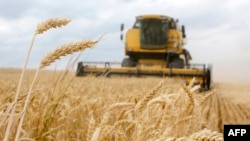"Agriculture is facing an historically unprecedented combination of challenges: the task of producing more food with less land, with less water, in the context of escalating conflict, and in the face of a rapidly changing climate,” according to Cary Fowler, the Biden Administration’s Special Envoy for Global Hunger.
Yet at the same time, said Under Secretary of State for Economic Growth, Energy, and the Environment Jose Fernandez, “this is a critical moment for food security.”
“In 2021, more than 160 million people worldwide experienced acute food insecurity, a 19 percent jump – a 19 percent jump – from the year before.”
“The issue of food security has grown even more urgent, and the effects of food insecurity are widespread and are devastating,” said Under Secretary Fernandez.
“When there is food insecurity, farmers lose their livelihoods. Parents spend hours every day trying to secure their family’s next meal. Hungry children struggle to learn, and they suffer irreversible health consequences. Already vulnerable populations are always, always hit hardest, and food insecurity also holds back broader economic growth and increases the risk of violent conflict and civil unrest.”
The United States is committed to the global fight against food insecurity both by addressing the root causes of hunger, and by meeting the immediate needs of those suffering worldwide, said Under Secretary Fernandez.
First, we are working to address the global food supply chain disruption and mobilizing resources to meet urgent humanitarian needs. To that end, since February, the United States has proved nearly $2.6 billion in emergency food assistance globally.
Second, we’re collaborating with partner countries to mitigate the global fertilizer shortage.
Third, we continue to boost agricultural capacity and resilience through Feed the Future, the U.S. Government’s global hunger and food security initiative.
Fourth, we’re working with numerous partners, the international financial institutions, and other multilateral organizations to provide immediate relief and to cushion the impact of rising food prices on the most vulnerable people.
And finally, to reach these goals, we are intensifying diplomatic engagement in our bilateral relationships and in international fora. This effort will also serve to bring together the countries most affected by food insecurity with those that are in the best position to help.
“This is a humanitarian crisis; it’s a health crisis. It’s an economic and national security issue. And simply put, it’s a moral issue,” said Under Secretary Fernandez. “No child – no child on Earth should have to go hungry.”
The Intersecting Challenges of Global Hunger and Climate Crisis

Agriculture is facing an historically unprecedented combination of challenges: the task of producing more food with less land, with less water, in the context of escalating conflict.













